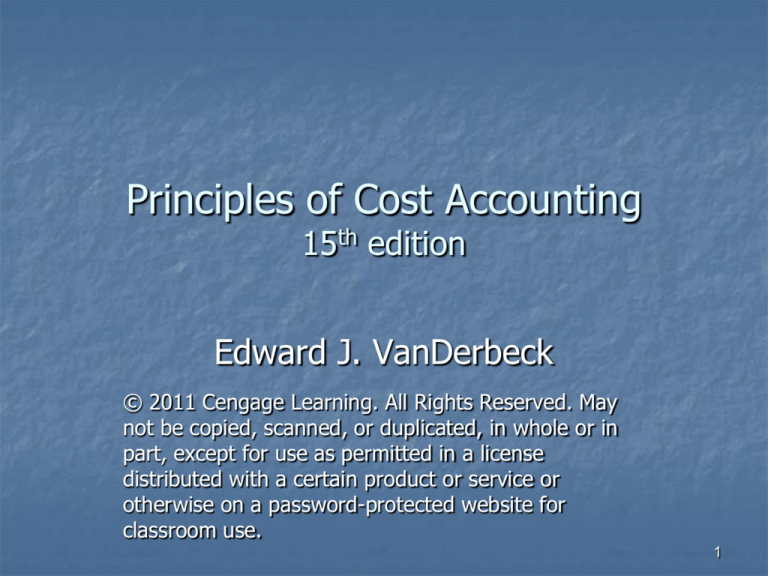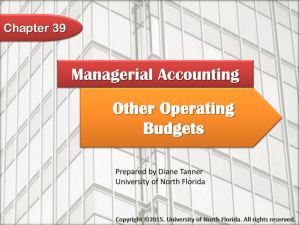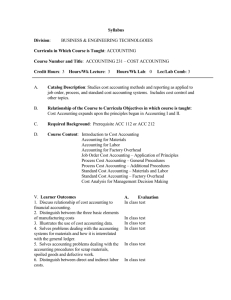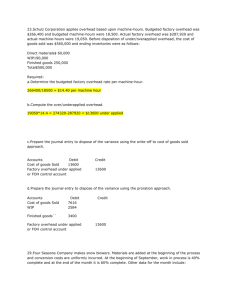
Principles of Cost Accounting
15th edition
Edward J. VanDerbeck
© 2011 Cengage Learning. All Rights Reserved. May
not be copied, scanned, or duplicated, in whole or in
part, except for use as permitted in a license
distributed with a certain product or service or
otherwise on a password-protected website for
classroom use.
1
Chapter 7
The Master Budget
and Flexible Budgeting
2
Learning Objectives
LO1 Explain the general principles involved
in the budgeting process.
LO2 Identify and prepare the components
of the master budget.
LO3 Identify and prepare components of
the flexible budget.
3
Learning Objectives (cont.)
LO4 Explain the procedures to determine
standard amounts of factory overhead
at different levels of production.
4
Principles of Budgeting
1.
2.
3.
4.
5.
6.
Define objectives.
Set realistic, possible goals.
Carefully consider economic developments, the
general business climate, and the condition of the
industry.
Constantly analyze the actual results as compared
with the budget.
Create a budget flexible enough to modify in the light
of changing conditions.
Clearly define the responsibility for forecasting costs
and the accountability for actual results.
5
Preparing the Master Budget
Master or static budget is prepared for
a single level of volume based on the best
estimate of the level of production and
sales for the coming period.
The sales budget is the starting point for
all budgets.
From the sales budget, production
requirements are determined.
6
Budgeted Income Statement
Sales budget
Cost of goods sold budget
Production budget
Direct materials budget
Direct labor budget
Factory overhead budget
Selling and administrative expenses
budget
7
Sales Budget
This is the basis for preparing all
other budgets.
Projects the volume of sales both
in units and dollars.
8
Production Budget
After the sales forecast and inventory levels
have been determined, management can
determine production requirements.
Units to be sold
Ending inventory required
Total
Beginning inventory
Units to be manufactured
Units per month (102,000/12)
100,000
4,500
104,500
2,500
102,000
8,500
9
Direct Materials Budget
The direct materials budget is prepared
once the production requirements have been
determined.
The desired ending inventory for each
material is added to the quantity needed to
meet production needs, and that total is
reduced by the estimated beginning
inventory to determine the amount of
materials to be purchased.
10
Direct Labor Budget
The production requirements are
used to prepare the direct labor
budget.
Standard labor time allowed per
unit is multiplied by the number of
units to be produced to obtain the
total direct manufacturing labor
hours.
11
Factory Overhead Budget
Consists of the estimated individual factory
overhead items needed to meet production
requirements.
Factory Overhead Budget
Indirect materials
Indirect labor
$225,000
375,250
Depreciation of building
85,000
Depreciation of machinery and equipment
67,500
Insurance and property taxes
48,750
Power and light
29,800
Total factory overhead cost
$831,300
12
Cost of Goods Sold Budget
Budget is prepared once the direct
material, direct labor, and factory
overhead budgets have been completed.
The estimated beginning inventories and
the desired ending inventories of WIP and
Finished Goods are included to compute
the cost of goods sold.
13
Selling & Administrative
Expenses Budget
The selling and administrative
expenses budget may be
prepared once the sales forecast
has been made.
This budget has separate
sections for selling and
administrative expenses.
14
Budgeted Income Statement
Once the preceding budgets have been
completed, the budgeted income statement
may be prepared.
If the budgeted profit does not meet
expectation, management may wish to
reevaluate their original estimates with
appropriate managers to determine what
changes might be made to improve profitability.
15
Budgeted Balance Sheet
Cash budget
Accounts receivable budget
Based on anticipated sales, credit terms, the economy, and
other relevant factors.
Liabilities budget
Shows the anticipated cash flow and the timing of cash receipts
and disbursements.
Reflects how the company’s cash position will be affected by
paying their liabilities.
Capital expenditures budget
A plan for the timing of acquisitions of buildings, equipment, or
other significant assets during the period.
16
Flexible Budgeting
A plan of what will happen to a company under
varying sets of conditions.
The company plans in advance what the effect
will be on revenue, expense, and profit if sales
or production differ from the budget.
Standard production is determined and the initial
calculation of variable and fixed costs is based
on this level of production.
17
Preparing the Flexible Budget
28,000 units
Sales ($150/unit)
30,000 units
32,000 units
$4,200,000
$4,500,000
$4,800,000
560,000
600,000
640,000
Paint ($4/unit)
112,000
120,000
128,000
Cutting ($3.75/unit)
105,000
112,500
120,000
Assembly ($2.40/unit)
67,200
72,000
76,800
Painting ($1.50/unit)
42,000
45,000
48,000
Variable FOH ($6.93/unit)
194,040
207,900
221,760
Variable S & A expenses ($25.79/unit)
722,120
773,700
825,280
$2,397,640
$2,568,900
$2,740,160
Fixed FOH
207,825
207,825
207,825
Fixed S & A expenses
773,825
773,825
773,825
$1,415,990
$1,587,250
$1,758,510
Direct materials: Lumber ($20/unit)
Direct labor:
Contribution Margin ($85.63/unit)
Operating income
18
Performance Report Based on
Flexible Budgeting
Budget
(28,000 units)
Sales ($150/unit)
Actual
(28,000 units)
Variance
$4,200,000
$4,250,000
$50,000 F
560,000
585,000
25,000 U
Paint ($4/unit)
112,000
108,000
4,000 F
Cutting ($3.75/unit)
105,000
120,000
15,000 U
Assembly ($2.40/unit)
67,200
72,000
4,800 U
Painting ($1.50/unit)
42,000
40,000
2,000 F
Variable FOH ($6.93/unit)
194,040
206,823
12,783 U
Variable S & A expenses ($25.79/unit)
722,120
719,456
2,644 F
$2,397,640
$2,398,721
$1,081 F
Fixed FOH
207,825
211,765
3,940 U
Fixed S & A expenses
773,825
770,550
3,275 F
$1,415,990
$1,416,406
$416 F
Direct materials: Lumber ($20/unit)
Direct labor:
Contribution Margin ($85.63/unit)
Operating income
19
Preparing the Flexible Budget for
Factory Overhead
The standard production level must first
be determined.
The manufacturing capacity must be
determined.
1.
2.
3.
Theoretical capacity
Practical capacity
Normal capacity
20
Semifixed Costs
Semifixed costs are those
that generally remain the same
in dollar amount through a wide
range of activity, but increase
when production exceeds
certain limits.
21
Semivariable Costs
Semivariable costs are those
that may change with production
but not necessarily in direct
proportion.
22
Service Department Budgets
and Variances
Expenses are estimated at different levels of
production, a standard rate for application of
service department expenses to production
departments is determined based on the type of
service and usage by the production departments.
Production departments are charged with service
department expenses at a standard rate, using
their actual activity base.
23
Summarization
of the Budgeting Process
1 A Sales Forecast (in units)
2 Inventory Policy (minimum-maximum and stable or fluctuating)
3 Production Plan (in units and by periods)
This information aids in developing the
4(a) Direct Material
Requirements
(quantities and prices)
4(b) Direct Labor
Requirements
(hours and rates)
4(c) Indirect Cost
Requirements
(type and behavior – variable,
semi-variable and fixed costs)
5(b) Direct Labor Budget
5(c) Factory Overhead
Budget
From this information is developed the
5(a) Direct Materials
Budget
From these budgets are developed the
6(a) Standard Product
Cost per Unit
6(b) Standard Cost per Unit
for Direct Labor
6(c) Standard Cost per Unit
for Factory Overhead
(These combined figures determine the Standard Unit Cost for the Product.)
24








